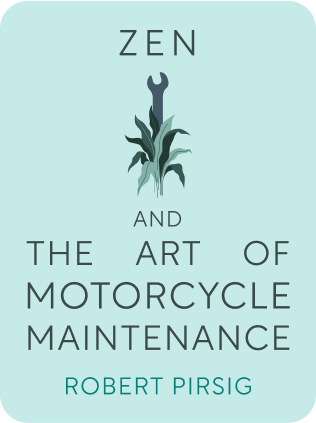

This article is an excerpt from the Shortform book guide to "Zen And The Art Of Motorcycle Maintenance" by Robert Pirsig. Shortform has the world's best summaries and analyses of books you should be reading.
Like this article? Sign up for a free trial here .
Who is Robert Pirsig? What is his role in Zen and the Art of Motorcycle Maintenance?
Robert Pirsig is the author of the book Zen and the Art of Motorcycle Maintenance. The book is considered an autobiographical novel, and Robert Pirsig’s life is an important part of the story.
Read more about Robert Pirsig and his book Zen and the Art of Motorcycle Maintenance.
Robert Pirsig: Author of Zen and the Art of Motorcycle Maintenance
A cultural touchstone of the Seventies, Robert Pirsig’s Zen and the Art of Motorcycle Maintenance (ZAMM) is a smorgasbord, equal parts autobiographical novel, travelogue, and collection of philosophical essays.
The book features a two-track structure. The first track, told in the present tense, follows an unnamed narrator (whom Shortform, because of the numerous parallels between the narrator and the real-life Robert Pirsig, has chosen to call “Pirsig”) and his 11-year-old son Chris on a motorcycle trip from Minnesota to California. This track features the vivid descriptive language, dialogue, plot, and character development typical of a realist novel.
The second track consists of a series of philosophical and autobiographical discourses. Robert Pirsig calls these discourses “Chautauquas.” (In the 19th century, Chautauquas were traveling tent shows that featured lectures from religious and intellectual figures.) Pirsig’s primary concerns in these Chautauquas are three:
- Modern technology and human beings’ relationship to it
- The story of Phaedrus, Pirsig’s alter-ego
- Phaedrus’s concept of “Quality”
The First Track: The Story
When the book begins, Pirsig and Chris have just left Minneapolis on motorcycles. They are accompanied by John and Sylvia Sutherland, friends of Pirsig, who are riding with the Pirsigs as far as Bozeman, Montana. Whereas Pirsig is an editor of technical manuals, John is a drummer, and their differing attitudes toward motorcycle maintenance provide the impetus for Pirsig’s early Chautauquas on technology.
As the riders make their way west, the Pirsigs’ backstory is slowly revealed. The key plot points are as follows:
- Some years before the ride, Pirsig suffered a mental breakdown and was institutionalized. He was treated with electroshock therapy, which caused him to forget who he was before the treatment. Through occasional fragments of memory and his own research, he’s been able to get a sense of the person he was before. He calls this person Phaedrus.
- Phaedrus was a gifted child who enrolled in college at 15 to study science. He found himself haunted by philosophical questions and eventually flunked out. After a stint in the army, he returned to college to study philosophy.
- After graduating, again consumed by existential questions, Phaedrus spent years in India studying philosophy. He found Eastern philosophy equally as unsatisfying as Western philosophy and returned to the States. He earned a graduate degree in journalism and wound up teaching rhetoric and composition at Montana State University in Bozeman.
- His experience teaching led him to the discovery of “Quality,” an indefinable philosophical concept from which (he thought) sprung all of human experience and endeavor. Both for professional and intellectual reasons, he decided to continue researching “Quality” in an interdisciplinary graduate program at the University of Chicago. It was while he was living and studying in Chicago that he suffered his breakdown.
- Chris has been causing trouble at home lately. He also suffers from chronic stomach aches, but no doctor has been able to find a physical cause. His caretakers fear he’s at risk of a breakdown as well.
In Bozeman, the group stays with an old colleague of Phaedrus named DeWeese. After a few days, the Sutherlands return to Minnesota, and the Pirsigs press on to California. As they near their destination, Pirsig fears that Phaedrus is reviving in his mind and another breakdown is imminent.
When the Pirsigs reach California, Chris’s mood is at its nadir. Pirsig feels compelled to have a frank talk with him. He tells Chris that he, Pirsig, was once insane, and that the doctors fear Chris will end up insane as well. (Shortform note: The terminology and overall depiction of mental disorders in the book is dated.) In response, Chris descends into a wailing fit. As Chris rocks and cries, Phaedrus speaks through Pirsig, and Chris responds favorably. When Chris asks if Pirsig was really insane, Phaedrus, through Pirsig, says no. Chris suddenly brightens, and the book ends with the Pirsigs cruising along the Pacific coast, reconciled.

———End of Preview———
Like what you just read? Read the rest of the world's best book summary and analysis of Robert Pirsig's "Zen And The Art Of Motorcycle Maintenance" at Shortform .
Here's what you'll find in our full Zen And The Art Of Motorcycle Maintenance summary :
- How an unnamed narrator and his son are on a cross-country motorcycle journey
- Why technology can be creative
- How to focus on what's in front of you in order to get exactly what you need






